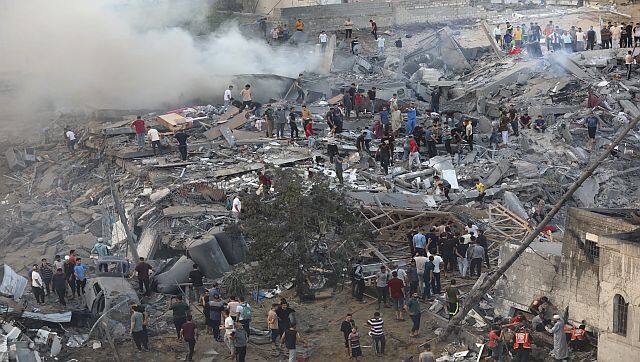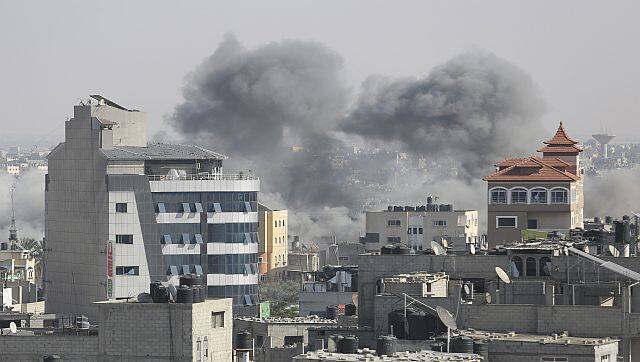Hundreds of thousands of Palestinians fled from north to south in the tiny, packed enclave after Israel threatened to strike the north, including Gaza City, in order to crush Hamas following its murdering and kidnapping spree in Israel on 7 October. Israel said it would be safer there. But Israel has intensified its overnight bombing of southern Gaza on Wednesday, where a Reuters report recorded numbers of Palestinians were killed. Israeli warplanes have continued to hit sites in southern Gaza, spreading fear among the evacuees that they are just as vulnerable there as they were in their homes in the north. According to the Gaza’s health ministry, the Palestinian death toll now exceeds 6,500. “This is something not normal, we have not heard something like this before,” said Khader Abu Odah, one of many stunned residents waiting for an excavator to lift rubble so they could look for survivors, as per a Reuters report. The fact that many of those who followed the directive to evacuate south are also dying has added to the Palestinians’ sense of betrayal and rage over the fatalities. The Israeli military says that Hamas, which took control in Gaza in 2005, has entrenched itself among the civilian population everywhere. Here is an overview of the situation. Why is Israel still hitting the south? Since telling Gazans to head south, the Israeli military (IDF) has continued to pound targets across the area, killing an unknown number of civilians. In all, authorities in Gaza say 6,546 Palestinians have died since Israeli strikes started on 7 October. Residents said the bombardment of the south intensified on 25 October. One strike brought down several apartment buildings in Khan Younis, some 10 km (six miles) from the Egyptian border. [caption id=“attachment_13297732” align=“alignnone” width=“640”] According to the Gaza’s health ministry, the Palestinian death toll now exceeds 6,500. AP[/caption] The IDF has said that even if Hamas’s main power centre is in Gaza City, it is nonetheless entrenched among the civilian population across the enclave. “Wherever a Hamas target arises, the IDF will strike at it in order to thwart the terrorist capabilities of the group, while taking feasible precautions to mitigate the harm to uninvolved civilians,” the military said on Wednesday, reiterating previous statements.
Also Read: Israel-Hamas war: Why the UN may stop all aid operations in Gaza
The military has said the homes where operatives live are “legitimate targets” even if civilians live alongside them. “The so-called private home is not a private home,” a senior Israeli air force officer told reporters in a recent briefing. Why did Israel order the evacuation south? The
Israeli military
said on 12 October that nearly half of Gaza’s 2.3 million population should move to the southern half of Gaza within 24 hours. The military said the order was aimed at moving civilians away from “Hamas terror targets”, which it believes are concentrated in the north. Military spokesman Jonathan Conricus subsequently said: “We are preparing the area for significant military activity in Gaza City. That is the next stage. That’s why we are asking civilians to go south of the Gaza River.” Israel has massed troops on the border with Gaza and is widely expected to launch a land invasion. [caption id=“attachment_13297742” align=“alignnone” width=“640”]
According to the Gaza’s health ministry, the Palestinian death toll now exceeds 6,500. AP[/caption] The IDF has said that even if Hamas’s main power centre is in Gaza City, it is nonetheless entrenched among the civilian population across the enclave. “Wherever a Hamas target arises, the IDF will strike at it in order to thwart the terrorist capabilities of the group, while taking feasible precautions to mitigate the harm to uninvolved civilians,” the military said on Wednesday, reiterating previous statements.
Also Read: Israel-Hamas war: Why the UN may stop all aid operations in Gaza
The military has said the homes where operatives live are “legitimate targets” even if civilians live alongside them. “The so-called private home is not a private home,” a senior Israeli air force officer told reporters in a recent briefing. Why did Israel order the evacuation south? The
Israeli military
said on 12 October that nearly half of Gaza’s 2.3 million population should move to the southern half of Gaza within 24 hours. The military said the order was aimed at moving civilians away from “Hamas terror targets”, which it believes are concentrated in the north. Military spokesman Jonathan Conricus subsequently said: “We are preparing the area for significant military activity in Gaza City. That is the next stage. That’s why we are asking civilians to go south of the Gaza River.” Israel has massed troops on the border with Gaza and is widely expected to launch a land invasion. [caption id=“attachment_13297742” align=“alignnone” width=“640”] Smoke rises after an Israeli airstrike on the Gaza Strip in Rafah. AP[/caption] On 18 October, the military urged residents of Gaza to evacuate to what it called a humanitarian zone in Al Mawasi, on the coast of southern Gaza. Israel renewed its warnings on 22 October, saying that anyone staying in the north could be identified as sympathisers of a “terrorist organisation” if they did not leave. How many people have moved? Hamas has urged Palestinians to ignore the Israeli warnings. Israel said on Wednesday it had attacked Hamas roadblocks that it believed were stopping people from evacuating. Despite Hamas’s attempts to stop an exodus, residents and international aid organisations say there has been a mass displacement of people away from the north and other areas of the enclave seen as especially vulnerable to attack.
Also Read: ‘Polite, wanted to talk politics’: The shocking stories of Hamas revealed by freed hostage
The United Nations Office for the Coordination of Humanitarian Affairs (OCHA) estimated on 24 October that more than 1.4 million people are internally displaced (IDPs) within Gaza. Gaza’s border crossings with both Egypt and Israel are closed, effectively trapping residents inside the enclave. What has the international community said? UN Secretary-General Antonio Guterres said giving hundreds of thousands of people just hours to leave their homes was “dangerous and deeply troubling”.
Also Read: How Israel is trying to get information on hostages held by Hamas
Many Western governments have called for a pause in the fighting to open humanitarian corridors for the trapped civilians. Arab nations have called for Israel to stop the war. With inputs from Reuters
Smoke rises after an Israeli airstrike on the Gaza Strip in Rafah. AP[/caption] On 18 October, the military urged residents of Gaza to evacuate to what it called a humanitarian zone in Al Mawasi, on the coast of southern Gaza. Israel renewed its warnings on 22 October, saying that anyone staying in the north could be identified as sympathisers of a “terrorist organisation” if they did not leave. How many people have moved? Hamas has urged Palestinians to ignore the Israeli warnings. Israel said on Wednesday it had attacked Hamas roadblocks that it believed were stopping people from evacuating. Despite Hamas’s attempts to stop an exodus, residents and international aid organisations say there has been a mass displacement of people away from the north and other areas of the enclave seen as especially vulnerable to attack.
Also Read: ‘Polite, wanted to talk politics’: The shocking stories of Hamas revealed by freed hostage
The United Nations Office for the Coordination of Humanitarian Affairs (OCHA) estimated on 24 October that more than 1.4 million people are internally displaced (IDPs) within Gaza. Gaza’s border crossings with both Egypt and Israel are closed, effectively trapping residents inside the enclave. What has the international community said? UN Secretary-General Antonio Guterres said giving hundreds of thousands of people just hours to leave their homes was “dangerous and deeply troubling”.
Also Read: How Israel is trying to get information on hostages held by Hamas
Many Western governments have called for a pause in the fighting to open humanitarian corridors for the trapped civilians. Arab nations have called for Israel to stop the war. With inputs from Reuters
Why is Israel attacking south Gaza after ordering civilians to go there?
FP Explainers
• October 26, 2023, 08:46:24 IST
Israel has told civilians in the northern Gaza Strip, including residents of Gaza City, to move to the south of the enclave, saying it will be safer there. However, Israeli warplanes have continued to hit sites in the south, spreading fear among the evacuees
Advertisement
)
End of Article